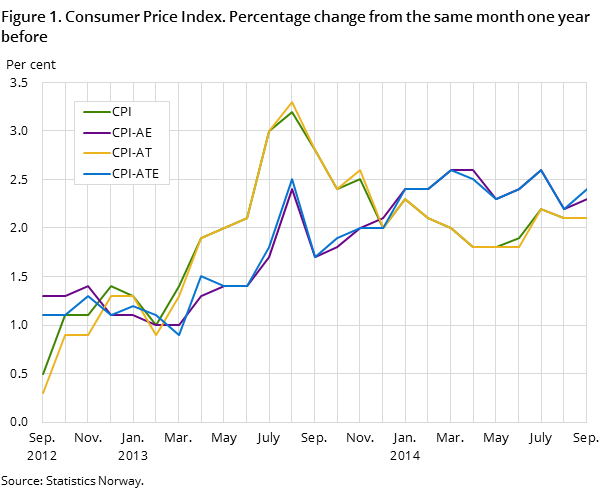Content
Published:
This is an archived release.
Higher prices on clothing gave rise in CPI
The Consumer Price Index (CPI) rose by 0.5 per cent from August to September, mainly due to higher prices on clothing, furniture and electricity. The year-to-year growth in the CPI was 2.1 per cent in September, while the CPI-ATE growth was 2.4 per cent in the same period.
| Monthly change (per cent) | 12-month rate (per cent) | Index | |
|---|---|---|---|
| August 2014 - September 2014 | September 2013 - September 2014 | September 2014 | |
| CPI All-item index | 0.5 | 2.1 | 137.7 |
| Food and non-alcoholic beverages | -0.6 | 2.4 | 129.9 |
| Housing, water, electricity, gas and other fuels | 0.8 | 2.0 | 169.8 |
| Transport | 0.0 | 2.5 | 150.5 |
| Recreation and culture | 0.3 | 2.2 | 119.6 |
| Clothing and footwear | 5.9 | -1.1 | 53.6 |
| CPI-ATE (july 1999 = 100) | 0.5 | 2.4 | 128.4 |
| CPI by delivery sector | |||
| Other consumer goods produced in Norway | 0.9 | 1.5 | 165.2 |
| Imported consumer goods | 1.2 | 1.4 | 91.2 |
| Other services with wages as dominating price factor | 0.5 | 3.8 | 211.6 |

The CPI was 137.7 (1998=100) in September 2014, compared to 134.9 in September 2013, which corresponds to a year-to-year growth of 2.1 per cent.
Monthly change: Price rise on clothing after summer sale
The CPI increased 0.5 per cent from August to September. In that period, prices on clothing and furniture and furnishing rose 6.7 and 7.3 per cent respectively. These price increases are normal as it is the end of the seasonal sales activity. From August to September, the price on electricity including grid rent went up by 4.0 per cent.
The most important factor in dampening the rise in the CPI was food prices, which fell by 0.9 per cent last month. It was also measured lower prices on fuels and non-durable household goods.
Year-to-year growth: More expensive food and beverages and higher rents
The CPI rose by 2.1 per cent from September 2013 to September 2014. Over the last twelve months, food and non-alcoholic beverages had a price increase of 2.4 per cent. Imputed rentals of home owners rose 2.5 per cent, and prices of transport services went up 5.3 per cent last twelve months.
The year-to-year growth in the CPI was mainly dampened by lower prices on clothing, electricity and non-durable household goods. Prices of electricity including grid rent fell by 2.0 per cent in the last twelve months. It was also price decreases for clothing, non-durable household goods, and fuels in the same period.
The year-to-year growth in the CPI in September was unchanged from August at 2.1 per cent. The year-to year growth in the CPI-ATE was 2.4 per cent in September, up 0.2 percentage points from August. The main contributor to the increased growth rate was the price development of clothing. These prices rose significantly more from August to September this year, that in the same period last year.
Contact
-
Statistics Norway's Information Centre
E-mail: informasjon@ssb.no
tel.: (+47) 21 09 46 42
-
Konsumprisindeksen
E-mail: konsumprisindeksen@ssb.no
tel.: (+47) 62 88 56 34
-
Camilla Rochlenge
E-mail: camilla.rochlenge@ssb.no
tel.: (+47) 40 90 23 72
-
Kjersti Nyborg Hov
E-mail: kjersti.nyborg.hov@ssb.no
tel.: (+47) 40 90 23 63
-
Gunnar Larsson
E-mail: gunnar.larsson@ssb.no
tel.: (+47) 40 90 26 79
-
Trym Kristian Økland
E-mail: trym.okland@ssb.no
tel.: (+47) 46 81 09 15
